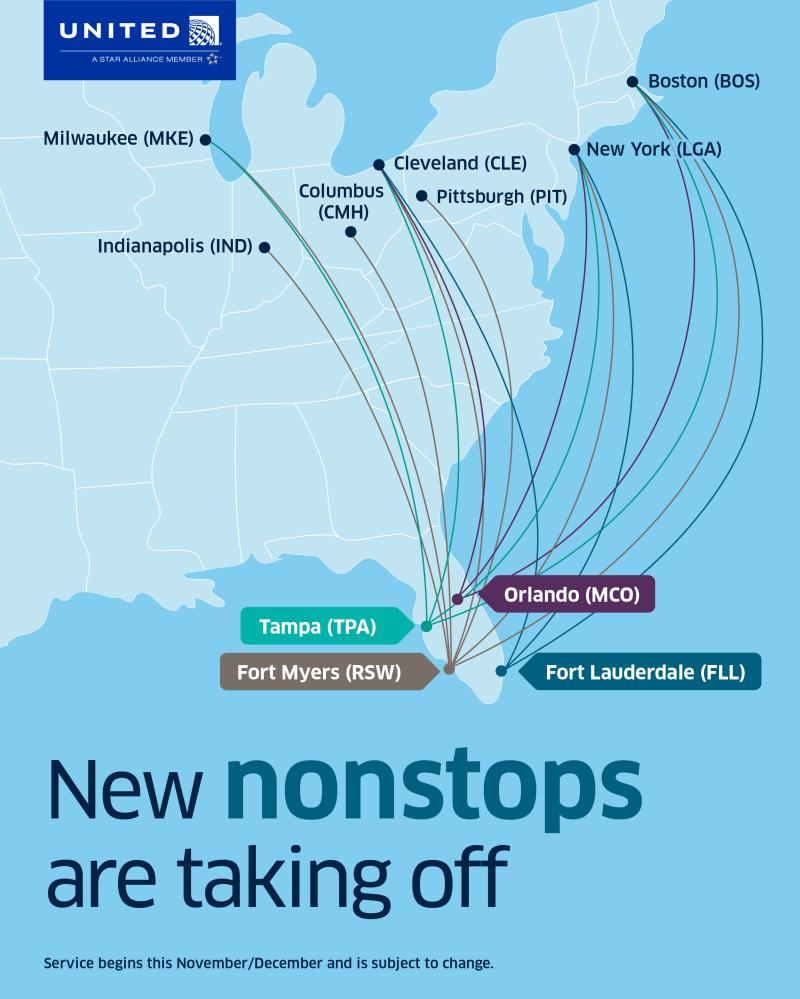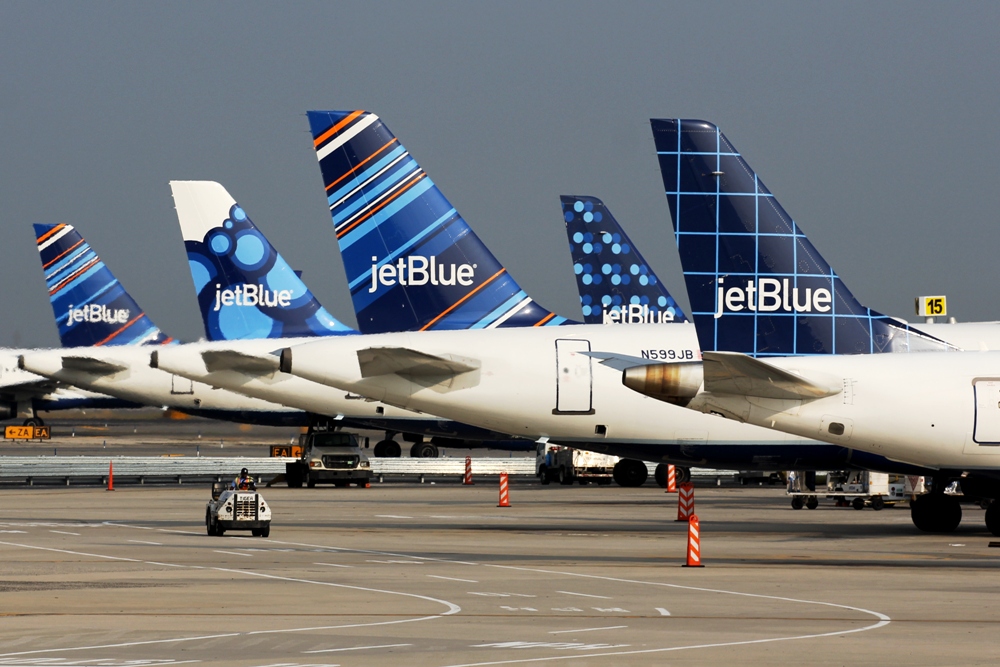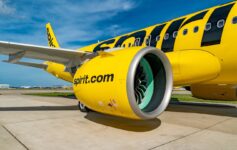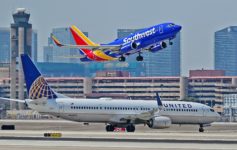See As airlines begin to alter their schedules for the coming months, they are moving away from the favored hub-and-spoke model in favor of non-stops.
If you are considering booking travel or signing up for a new credit card please click here. Both support LiveAndLetsFly.com.
If you haven’t followed us on Facebook or Instagram, add us today.
Airlines Announce New Non-Stop Flights
United announced 17 new non-stop flights to Florida for the winter and holiday season. Matthew covered these routes, one of which I am greatly anticipating from Pittsburgh to Fort Myers, FL. Most of the flights originate in either Cleveland, Boston, or New York LaGuardia. As Matthew noted, Cleveland and LaGuardia are older focus cities/former hubs which make sense since the carrier has all but abandoned each in the favor of Newark, Washington Dulles, and Chicago.

JetBlue has added 30 new flights (some of which are) from non-hubs to non-hubs as well. While Mint service and other routes are a big change, I am personally focused on the flights the carrier has added from Pittsburgh; West Palm Beach (PBI), and adding back its southern hub, Fort Lauderdale/Hollywood. The latter was a route the carrier canceled and a favorite for my family because we could utilize our Chase Ultimate Rewards points using this True Blue trick as Jet Blue is a transfer partner from Chase. The carrier had dropped Fort Lauderdale from Pittsburgh where it faced competition from Spirit and Southwest. The PIT-PBI route picks up where OneJet left off after the carrier went under.
Adding non-stop flights by these two carriers, in particular, make holding Chase Ultimate Rewards cards even more valuable as both are transfer partners of the program.

Leisure, Leisure, Leisure
There is no business traffic right now. None. The airlines have all mentioned this in their earnings calls. Allegiant rightly recognized that theleisure market was the only one flying right now and that the carrier thinks this creates a unique business opportunity for them to capture former loyalists from other carriers.
Maybe United was listening.
I stated in the Allegiant post that (though I am both a United 1K and American Airlines Executive Platinum member) I fly Spirit to Florida because the flights are cheap but mostly because adding a connection doubles my transit time with little to no benefit. Sure, I can snag an upgrade (and I hope to do so on the Pittsburgh-Fort Myers route) but mostly, I just don’t want to add an extra flight to my journey. The same would be true for those in Cleveland, Boston, or New York, the latter two have far too many direct options to add a connection for leisure flyers. Flyers just won’t add a stop in Chicago or Dulles (and definitely not Houston) to go from the Northeast to the Sunshine state. If United fails to offer more convenient options, they cede that business to those that will. Thus, the 17 new routes they have added exclusively to serve the leisure market.
Hub-and-Spoke Model
The hub-and-spoke model most of us have become accustomed to makes more sense for business travel and the broadest brush of trips. Business people need to be able to get to destinations all over the world. It makes sense to load planes on connections rather than flying point-to-point. However, carriers like American are abandoning smaller markets altogether. There simply is not enough traffic for the hub model to make sense.
While it isn’t logical to fly twice-daily from Boise, ID to Orlando, FL it may make enough sense to do so on a twice-weekly basis, a model that Allegiant employs Likewise, residents of Boise do not necessarily want to only fly on a Wednesday or a Sunday to Orlando so schedule restrictions at Allegiant are less attractive than the hub-and-spoke model at the major carriers. They can fill many planes from around the country through centralized points onward to Orlando.
The hub-and-spoke model breaks down when it takes far too many unprofitable flights from Boise, Reno, Omaha, and similar markets just to fill up a few planes onward to Orlando.
How Many Will Stay?
One airline has long been a fan of random non-hub O&D flights, enter: the “Delta Dartboard.” Delta has been famous for throwing a route out when they secure a business contract to see if they can fill a plane. Delta Air Lines operated a 5x weekly flight from Pittsburgh to Paris on a 757 (likely due to a corporate contract guarantee from a large company.) Delta has since discontinued that flight but oddly added an Indianapolis-Paris flight some time ago. The strategy seems to work for Delta on many routes, but their past habits indicate a willingness to try non-stop routes between non-hub cities and an equal willingness to abandon them if they don’t work out.
Just how many of the new point-to-point routes will stay is anyone’s guess. However, it’s my opinion that airlines have been more willing than ever before to stretch and bend their models. For the foreseeable future, I can neither see an airline sticking out a route that’s not making money nor abandoning those that are profitable solely to return to their hub model. While it may have been a little more difficult to make schedule banks and aircraft assignments work with planes operating out of the rest of the system, it wasn’t and isn’t impossible.
As a shareholder of multiple airlines (some that offer mostly point-to-point and some that offer hub-and-spoke), my primary focus is that profitable routes stay and that limited exploration continues to identify new routes.
Conclusion
I love the idea of airlines trying new things to explore where travelers are flying now, and in the case of United, will do so in the future. I also support their right to discontinue flights that no longer make sense, even if it makes it less convenient for me to travel to those destinations in the future.
What do you think? Are non-stops to non-hub destinations the new normal? Do you have some suggested routes carriers should try?




Delta flew Pittsburgh-Paris because the airport authority paid them a handsome revenue gauzes here subsidy. They got a better deal with BA for year round London flights and delta dropped Paris. End of story. All pretty well publicized in the Pittsburgh press
There’s nothing odd about the delta Indianapolis- Paris flight either. The local airport authority and local businesses subsidize the route. Nothing strange about it
*cries in A380*
Airlines that truly fly long distance internationally need a hub and spoke model
– you are unlikely to fill an A 380 from Boise to Leeds or Cardiff UK
Those that are mainly domestic – SW, Spirit – can do point to point. SW is domestic
– for all intents and purposes the Caribbean places they go to are like a few extra cities in the south
Since both business travel and international trips are down, expect volumes to fall at UA, AA and DL and to recover more quickly at SW Spirit Frontier and Allegiant Alaska and JetBlue are in between HI is closed
SW also has a lot of business travelers but they have only 1 type of plane so they do not need to do complex adjustments in staffing and planes and routes
Airlines cannot scale without hubs. Even Frontier, which is probably the least hub focused, has significant constraints for leisure travelers including infrequent flights (less than daily) and restricted flight times.
The routes that United announced is only valid for two months to capture as much leisure traffic as possible to increase utilization on a fleet that is significantly underutilized due to covid.
American’s intent to leave SOME small markets is because marginal or money losing stations must be cut under the current environment to reduce cash burn.
The hub structure is not going away. There might be one off’s here and there to increase utilization but for the time being, but once airlines grow to a certain point, hubs must be used to offer the most destinations to the most cities in your network,
ERI to SRQ or RSW as a nonstop, seasonal flight a couple days a week would be profitable.
People from the surrounding area would fill those planes. Conneaut. Ohio folks would come to Erie (a 40 min drive) instead of going to Akron, Youngstown or CLE.. And folks in the Erie and surrounding area would be thrilled to fly out of Erie nonstop to Fla’s west coast instead of driving to CLE, BUF, PIT, Akron or Youngstown. Trust me on this!!
Probably not…in Cleveland you have a lot of low carriers with non-stop flights…why would people drive over 40 minutes to Erie for what probably would be a more expensive ticket? It’s just easier to consolidate in Cleveland.
Also, delta’s flights from Pittsburgh and Indianapolis were absolutely not “non hub o&d” as you incorrectly post. They were hub spoke flights, tying into the Paris hub of joint venture partner Air France. Pittsburgh was the spike, Paris the hub. The vast majority of people on those flights- 50% or more- were connecting over Paris to other places in Europe, Africa, etc. just in the same way that over 50% would use Houston as a transit point only on a typical UA Pittsburgh – Houston flight. Do better research and really understand what you are writing about before making weird untrue claims.
in general, i think these are ‘not-defensable” in normal times. no real strength on either end….your traffic easily robbed by the likes of Frontier, Spirit and Allegiant; and then forced to compete at their price point. However, these are not normal times and normal thinking is not a good thing. Over the medium to long term, i think these will disappear, or will become tag ends on hub=spoke flights. (one stops-ff you will)
Hi Kyle, as a Indy based flyer I can report that the Delta IND-CDG flight was indeed subsidized by local/state government. I work for a large company in Indy and we, along with a few others, used it routinely as a bridge to Europe, as did many leisure flyers. It became very popular and my understanding from my contacts was the flight was doing well for DL even without the subsidy. We certainly understand why they pulled it as our business travel is down about 95% and we are not likely to ramp up travel anytime soon, or at all. We hope DL will bring this flight back, but given the business travel projections for the next year or so, I am not optimistic.
PS: I miss seeing Lucy travel the world!
Me too, Mike. Me too.
Overall, the hub and spoke model is more efficient for the airlines. I’m old enough (and an airgeek at a young age) to recall when airline routes were regulated and routes were much more similar to that of a bus line or rail. Multiple stops in smaller cities on a mainline jet with non-stops between large cities. I even recall taking an AA nonstop from IAD to SAN in 1969. As I was telling this story to my kids, I questioned my memory – what a random routing that would be. Well, I looked it up and yes AA had that route! And not all that many coast to coast flights either. And there were a lot of such routes – because they were regulated and ticket prices set by the CAB.
Anyhow, such a system is inefficient which is why the hub and spoke model is what major airlines use. This entire plandemic has greatly disrupted travel patterns and has caused airlines to scramble. But this is temporary. Once business travel returns, so will a heavy reliance on hubs. Why? Because they’re the most efficient and cost-effective way for airlines to operate at scale.
When I was a kid, I used to fly to FLL a few times a year to see my grandparents (flying before I could talk, apparently when we hit turbulence I’d go, “Weeeeeeh!” so an AV Geek from the begining). I believe it was National but they had a flight from PHL to FLL with a stop at…BWI. Showing my age but I remember that short jump to Baltimore since once we took off from BWI I’d get breakfast (hated eggs, loved sausage…apparently I’d ask those around me if they wanted to trade).
I may be relocating in the near future and my selection of airlines will go according:
1. Empty middle seat
2. Non-stop
In my case they narrows things down to Southwest. My other option would be Delta but they require a stop in Detroit, Minn or somewhere.